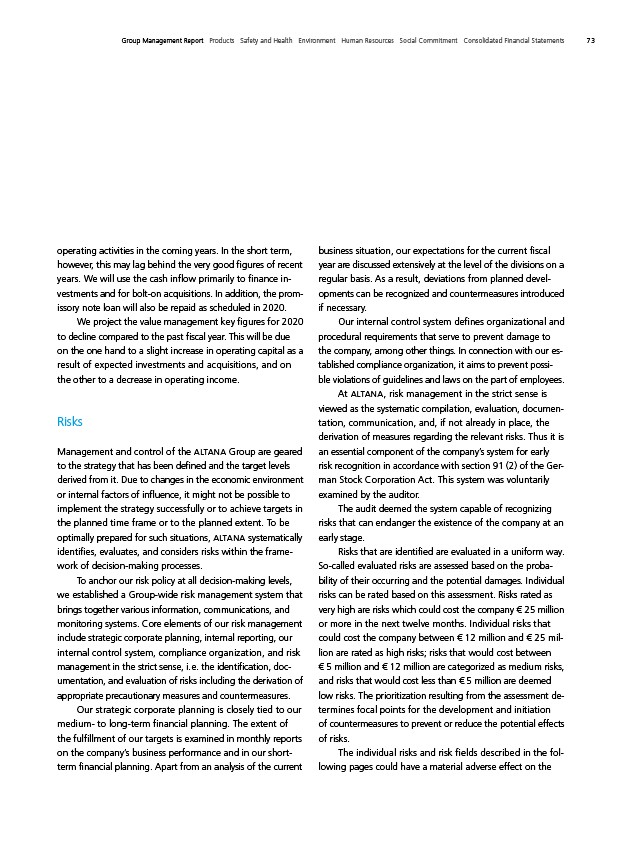
Group Management Report Products Safety and Health Environment Human Resources Social Commitment Consolidated Financial Statements 73
business situation, our expectations for the current fiscal
year are discussed extensively at the level of the divisions on a
regular basis. As a result, deviations from planned devel-
opments can be recognized and countermeasures introduced
if necessary.
Our internal control system defines organizational and
procedural requirements that serve to prevent damage to
the company, among other things. In connection with our established
compliance organization, it aims to prevent possi-
ble violations of guidelines and laws on the part of employees.
At ALTANA, risk management in the strict sense is
viewed as the systematic compilation, evaluation, documentation,
communication, and, if not already in place, the
derivation of measures regarding the relevant risks. Thus it is
an essential
component of the company’s system for early
risk recognition in accordance with section 91 (2) of the German
Stock Corporation Act. This system was voluntarily
examined by the auditor.
The audit deemed the system capable of recognizing
risks that can endanger the existence of the company at an
early stage.
Risks that are identified are evaluated in a uniform way.
So-called evaluated risks are assessed based on the probability
of their occurring and the potential damages. Individual
risks can be rated based on this assessment. Risks rated as
very high are risks which could cost the company € 25 million
or more in the next twelve months. Individual risks that
could cost the company between € 12 million and € 25 million
are rated as high risks; risks that would cost between
€ 5 million and € 12 million are categorized as medium risks,
and risks that would cost less than € 5 million are deemed
low risks. The prioritization resulting from the assessment determines
focal points for the development and initiation
of countermeasures to prevent or reduce the potential effects
of risks.
The individual risks and risk fields described in the following
pages could have a material adverse effect on the
operating activities in the coming years. In the short term,
however, this may lag behind the very good figures of recent
years. We will use the cash inflow primarily to finance investments
and for bolt-on acquisitions. In addition, the promissory
note loan will also be repaid as scheduled in 2020.
We project the value management key figures for 2020
to decline compared to the past fiscal year. This will be due
on the one hand to a slight increase in operating capital as a
result of expected investments and acquisitions, and on
the other to a decrease in operating income.
Risks
Management and control of the ALTANA Group are geared
to the strategy that has been defined and the target levels
derived from it. Due to changes in the economic environment
or internal factors of influence, it might not be possible to
implement the strategy successfully or to achieve targets in
the planned time frame or to the planned extent. To be
optimally prepared for such situations, ALTANA systematically
identifies, evaluates, and considers risks within the framework
of decision-making processes.
To anchor our risk policy at all decision-making levels,
we established a Group-wide risk management system that
brings together various information, communications, and
monitoring systems. Core elements of our risk management
include strategic corporate planning, internal reporting, our
internal control system, compliance organization, and risk
management in the strict sense, i. e. the identification, documentation,
and evaluation of risks including the derivation of
appropriate precautionary measures and countermeasures.
Our strategic corporate planning is closely tied to our
medium- to long-term financial planning. The extent of
the fulfillment of our targets is examined in monthly reports
on the company’s business performance and in our shortterm
financial planning. Apart from an analysis of the current